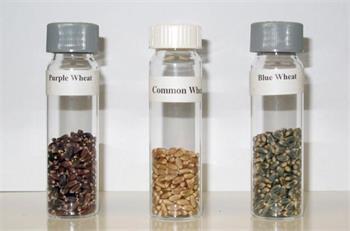 |
Researchers develop colourful purple wheat to boost health, economy
 |
TORONTO – Consumers and food producers may soon be able to reap the benefits of blue or purple wheat.
Scientists at the Guelph Food Research Centre of Agriculture and Agri-Food Canada, in conjunction with the University of Saskatchewan, have been studying the potential of the unusually coloured grain as a food ingredient and for its antioxidant values, said research scientist Dr. Elsayed Abdelaal.
“It would also benefit the wheat industry as a whole because you (will) have more choices for farmers, for producers, food processors and also, at the end of the day, for consumers,” he said from Guelph, Ont.
The researchers have been testing the wheat’s yield and ability to perform under Saskatchewan’s growing conditions.
Until now, much research has focused on different coloured fruits and vegetables, paying little attention to the development of coloured grain as a functional food (a modified food that claims to improve health or well-being by providing benefit beyond that of the traditional nutrients it contains).
Canada’s spring wheat is usually red or white in colour, but it is possible to breed high-anthocyanin blue pigments in these wheat varieties.
Abdelaal, who has been with the department since 1999, has been working on a process to isolate anthocyanin, or pigments, from the grain. Once separated, the anthocyanins can be used to protect and colour foods and cosmetic products.
Anthocyanins are the phytochemicals responsible for blue, purple or red pigments in highly pigmented grains, fruits and vegetables and have strong antioxidant activity levels. Purple or blue wheat bran (at 495 milligrams per kilogram) contains more anthocyanins than red cabbage (250 mg/kg).
Antioxidants are substances such as vitamins E or C that are thought to protect body cells from the damaging effects of oxidation and reduce the risk of chronic diseases like cancer, heart disease and diabetes.
Abdelaal said the blue or purple wheat could be used in foods like muffins and such dairy products as yogurt. A powder derived from the wheat could be used in skin-care products.
It is hoped the research will open new market opportunities for Canada’s farmers and food processors when the project wraps up in early 2015.
The coloured wheat is not genetically modified. Some consumers are concerned about the presence of synthetic pigments or colours added to their food. But the beauty of these products, Abdelaal noted, is that they would be a source of naturally occurring antioxidant.
Abdelaal said his group, “a pioneer in this area,” first published research in 1999 showing the potential of blue wheat as a healthy food ingredient.
This has led to interest among scientists elsewhere. Researchers in the U.S. are working on developing black sorghum while there is testing being done on blue and red rice in China. Abdelaal is also researching blue, purple and red corn and blue and black barley.
By Lois Abraham
The Canadian Press
1387 page views
|
|
|
|